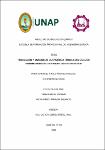| dc.contributor.advisor | García Pérez, Víctor | es_PE |
| dc.contributor.author | Fachin Espinar, Tania | es_PE |
| dc.contributor.author | Rimachi Dulanto, Kevin Fredy | es_PE |
| dc.date.accessioned | 2021-01-08T20:58:55Z | |
| dc.date.available | 2021-01-08T20:58:55Z | |
| dc.date.issued | 2019 | |
| dc.identifier.uri | http://repositorio.unapiquitos.edu.pe/handle/20.500.12737/7000 | |
| dc.description.abstract | En el presente trabajo, se ha realizado la “simulación y análisis de la eficiencia térmica del ciclo de Rankine usando el software Aspen HYSYS V8.0”. El paquete de fluido seleccionado o “Fluid Package” fue el de Soave/Redlich/Kwong (SRK), pues este modelo termodinámico es ideal para el cálculo de la densidad de fluidos a altas presiones y bajas temperaturas. Para esto se ha planteado los siguientes casos de estudio.
Caso 1: Ciclo de Rankine simple, en este ciclo la línea de salida de la caldera es vapor saturado a 120 bar, siendo la presión de trabajo en el condensador de 0.08 bar. El flujo másico del vapor es 2 kg/s. Se desea determinar el flujo de calor transferido al ciclo, la potencia suministrada por la bomba al fluido de trabajo, la potencia producida en la turbina y la eficiencia del ciclo.
Caso 2: Ciclo de Rankine con sobrecalentamiento, en este ciclo la línea de salida de la caldera es vapor saturado a 120 bar y luego se le aumenta su temperatura a presión constante en el sobrecalentador hasta 600 °C, a continuación el vapor sobrecalentado se expansiona en la turbina hasta 0.08 bar (presión de trabajo del condensador). El flujo másico del vapor es 2 kg/s. Se desea determinar el flujo de calor transferido al ciclo, la potencia suministrada por la bomba al fluido de trabajo, la potencia producida en la turbina y la eficiencia del ciclo.
En ambos casos de estudio se determinó la eficiencia térmica, siendo el para el primer caso 38% y 42% para el segundo caso, de lo cual se pudo concluir que el ciclo de Rankine con sobrecalentamiento es más eficiente que el ciclo de Rankine simple. | es_PE |
| dc.description.abstract | In the present work, the "simulation and analysis of the thermal efficiency of the Rankine cycle using the Aspen HYSYS V8.0 software" has been carried out. The selected fluid package or “Fluid Package” was that of Soave / Redlich / Kwong (SRK), as this thermodynamic model is ideal for calculating the density of fluids at high pressures and low temperatures. For this, the following case studies have been proposed.
Case 1: Simple Rankine cycle, in this cycle the boiler outlet line is saturated steam at 120 bar, with the working pressure in the condenser being 0.08 bar. The mass flow of the steam is 2 kg/s. It is desired to determine the flow of heat transferred to the cycle, the power supplied by the pump to the working fluid, the power produced in the turbine and the efficiency of the cycle.
Case 2: Rankine cycle with superheating, in this cycle the boiler outlet line is saturated steam at 120 bar and then its temperature is increased at constant pressure in the superheater up to 600 °C, then the superheated steam expands in the turbine up to 0.08 bar (condenser working pressure). The mass flow of the steam is 2 kg/s. It is desired to determine the flow of heat transferred to the cycle, the power supplied by the pump to the working fluid, the power produced in the turbine and the efficiency of the cycle.
In both study cases, the thermal efficiency was determined, being 38% for the first case and 42% for the second case, from which it could be concluded that the Rankine cycle with superheating is more efficient than the simple Rankine cycle. | es_PE |
| dc.format | application/pdf | es_PE |
| dc.language.iso | spa | es_PE |
| dc.publisher | Universidad Nacional de la Amazonía Peruana | es_PE |
| dc.rights | Attribution-NonCommercial-NoDerivs 3.0 United States | es_PE |
| dc.rights | info:eu-repo/semantics/openAccess | es_PE |
| dc.rights.uri | http://creativecommons.org/licenses/by-nc-nd/3.0/us/ | * |
| dc.source | Repositorio institucional - UNAP | es_PE |
| dc.source | Universidad Nacional de la Amazonía Peruana | es_PE |
| dc.subject | Simulación por computadora | es_PE |
| dc.subject | Aplicación de software | es_PE |
| dc.subject | Termodinámica | es_PE |
| dc.title | Simulación y análisis de la eficiencia térmica del ciclo de rankine usando el software Aspen Hysys v8.0 | es_PE |
| dc.type | info:eu-repo/semantics/bachelorThesis | es_PE |
| thesis.degree.discipline | Ingeniería Química | es_PE |
| thesis.degree.grantor | Universidad Nacional de la Amazonía Peruana. Facultad de Ingeniería Química | es_PE |
| thesis.degree.name | Ingeniero(a) Químico(a) | es_PE |
| thesis.degree.program | Presencial | es_PE |
| dc.subject.ocde | http://purl.org/pe-repo/ocde/ford#2.03.03 | es_PE |
| renati.author.dni | 05343731 | |
| renati.author.dni | 46476372 | |
| renati.advisor.dni | 5277951 | |
| renati.type | http://purl.org/pe-repo/renati/type#tesis | |
| renati.discipline | 531026 | |
| renati.level | http://purl.org/pe-repo/renati/level#tituloProfesional | es_PE |
| renati.juror | Suarez Rumiche, Jorge Antonio | |
| renati.juror | Perdiz Dávila, José Manuel | |
| renati.juror | Salas Barrera, Fernando Javier | |


